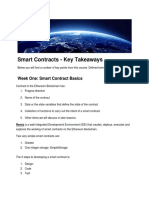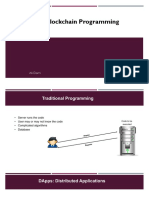0% found this document useful (0 votes)
31 views24 pagesLecture 10.developing Smart Contracts in Solidity
This document provides a comprehensive overview of Solidity, a programming language for developing smart contracts on the Ethereum blockchain. It covers key concepts such as data types, functions, error handling, security best practices, and tools for development, emphasizing the importance of security and optimization in smart contract creation. The document concludes with a discussion on the future of Solidity and its evolving role in decentralized applications.
Uploaded by
malik saadCopyright
© © All Rights Reserved
We take content rights seriously. If you suspect this is your content, claim it here.
Available Formats
Download as PPTX, PDF, TXT or read online on Scribd
0% found this document useful (0 votes)
31 views24 pagesLecture 10.developing Smart Contracts in Solidity
This document provides a comprehensive overview of Solidity, a programming language for developing smart contracts on the Ethereum blockchain. It covers key concepts such as data types, functions, error handling, security best practices, and tools for development, emphasizing the importance of security and optimization in smart contract creation. The document concludes with a discussion on the future of Solidity and its evolving role in decentralized applications.
Uploaded by
malik saadCopyright
© © All Rights Reserved
We take content rights seriously. If you suspect this is your content, claim it here.
Available Formats
Download as PPTX, PDF, TXT or read online on Scribd
/ 24


















































































































